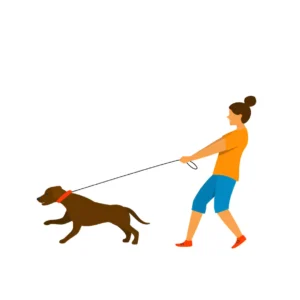Service Dog Training: A Comprehensive Guide to Transforming Lives
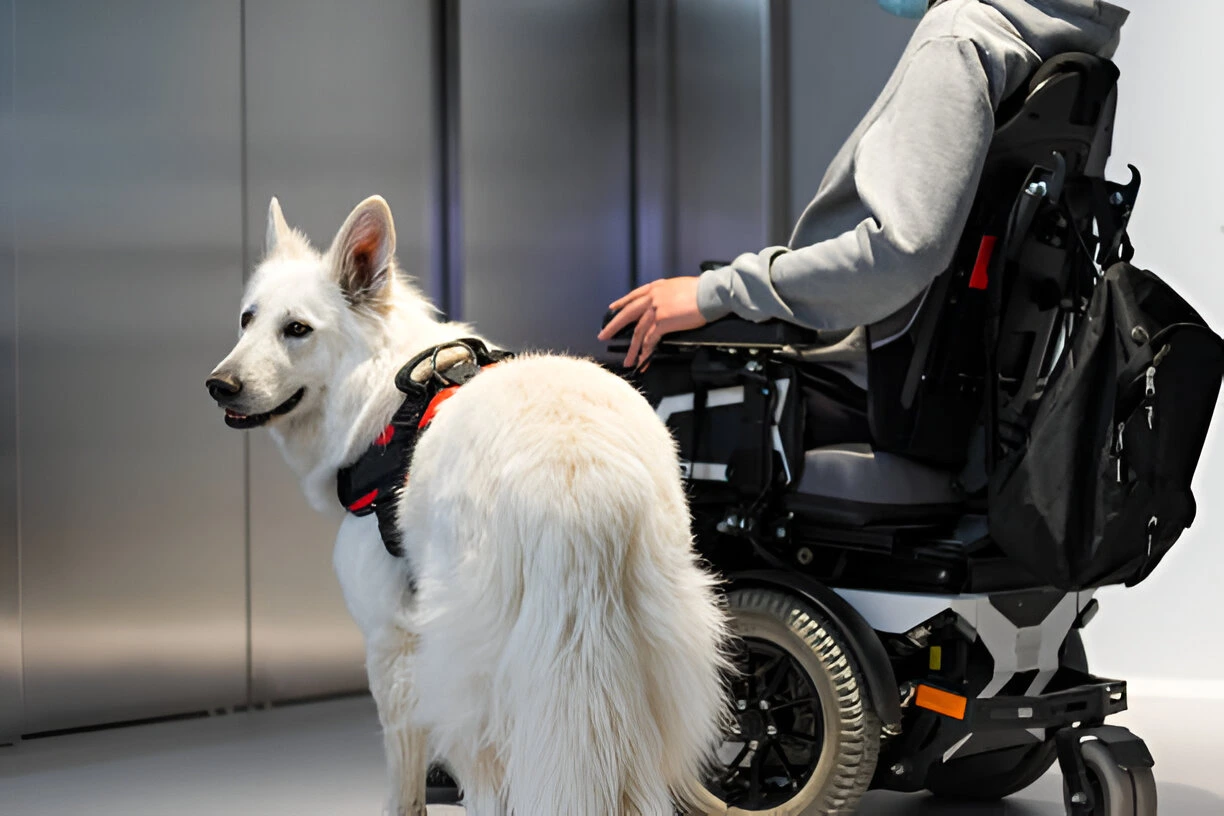
How long does it take to train a service dog? Have you ever wondered this? Continue reading to find out how long it takes.
The United States is home to approximately 500,000 service dogs. Guide dogs, diabetic alert service dogs, and autism service dogs are a few examples of these service dogs. People who require assistance greatly benefit from service dogs, but how long does it take to train a service dog? Who owns the dogs, and how much does the training cost?
We have the answers if you’re interested in these questions. Come along with us as we discuss the whole process. Also, we will guide you in detail on how long it takes to train a service dog.
A Service Dog: What Is It?
A service dog is a canine that has been specifically trained by handlers or trainers to assist individuals with disabilities. They perform many crucial duties, including monitoring for signs of illness onset and providing comfort to their handlers during panic attacks.
While some service dog training necessitates the handler’s involvement, service dogs can also be trained by professional trainers before being paired with a handler. To achieve this, the handler and dog must be paired when they are puppies.
Socialization with People and Other Animals
Socialization with other people and animals occurs alongside environmental socialization. A service dog that is aggressive or anxious around people is problematic. It poses a risk to the public and can make many situations difficult for both the handler and the dog.
Also, it can cause serious issues in public places if service dogs become overstimulated by other dogs or exhibit a desire to chase a cat. Even worse, if a mobility dog walking next to a handler who is unsteady on their feet were to chase a cat, they could injure and drag their handler down. The safety of these service dogs’ handlers depends on ensuring they do not become overstimulated by animals.
When to Start Training a Service Dog
Setting goals, basic obedience training, task training, public access training, temperament evaluation, and continuing skill support are all part of training service dogs.
The majority of experts recommend starting training a service dog puppy between the ages of 6 months and one year. This is because they are mature enough to concentrate and understand training cues at this age.
However, you can begin short, enjoyable sessions of basic socialization and fundamentals as soon as you get your puppy. Evaluating a service dog’s temperament is an essential part of their training. This ensures they possess the qualities needed for service work.
Many dog owners ask the question, “How long does it take to train a service dog?” Typically, it takes around one to two years to train a service dog. Setting specific goals is crucial after this is complete. This serves as a training roadmap.
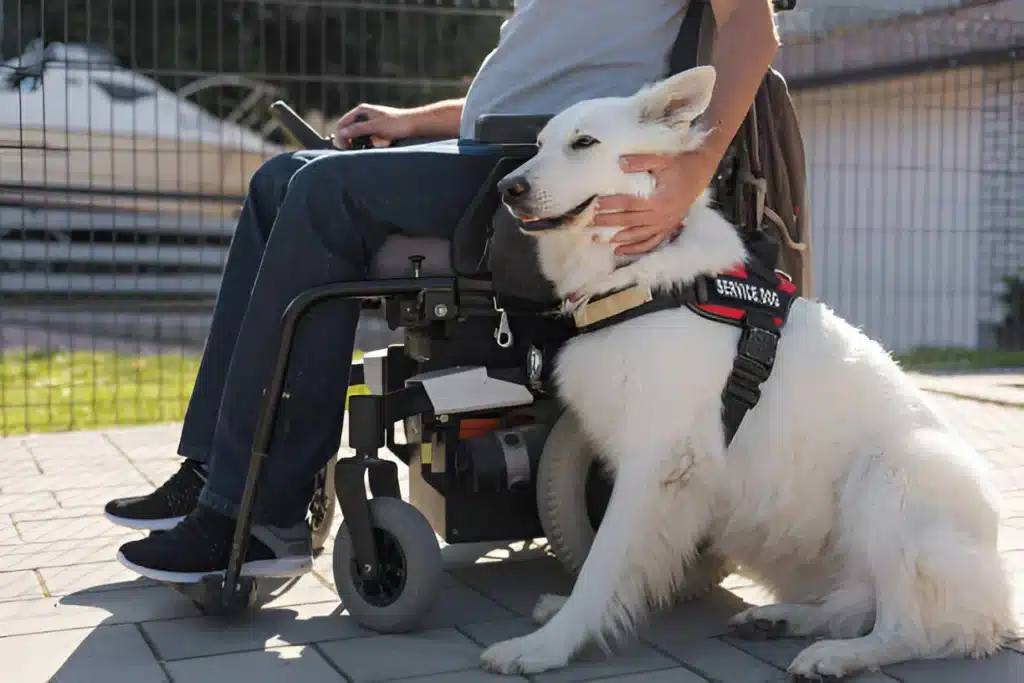
What Standards Do Service Dogs Need to Meet?
Not all dogs are suitable for service dog training. They must meet certain requirements to qualify. Some of the traits of service dogs that must be considered include:
Age:
It is recommended to start training a service dog between six months and a year. Socialization and potty training are crucial at this age.
Breed:
Breed is a significant consideration when choosing a service dog. First, utilizing an existing trait is simpler than creating one from scratch. Second, understanding the genetic characteristics of your breed will help you determine when and how they may affect a service dog’s reliability.
Training Proficiency and Level:
Training level and aptitude are also crucial. Service training will be considerably easier if the dog is exceptionally adept at picking up new skills or has previously received obedience or agility training.
Behavioral and Temperament Disorders:
Temperament is a major factor when determining whether a dog is suitable for a given service or not. An aggressive dog is unsuitable to assist someone with a disability.
Size:
The dog’s size when fully grown must be taken into account. This is particularly crucial if a mobility assistance service dog is required. Breeds that are too large may also have problems with laws pertaining to public transportation, etc.
How Long Does it Take to Train a Service Dog?
Fully training service dogs typically takes two years. However, this can vary depending on the dog and the training.
Training continues throughout the dog’s life rather than ending when the dog graduates and passes all of the tests.
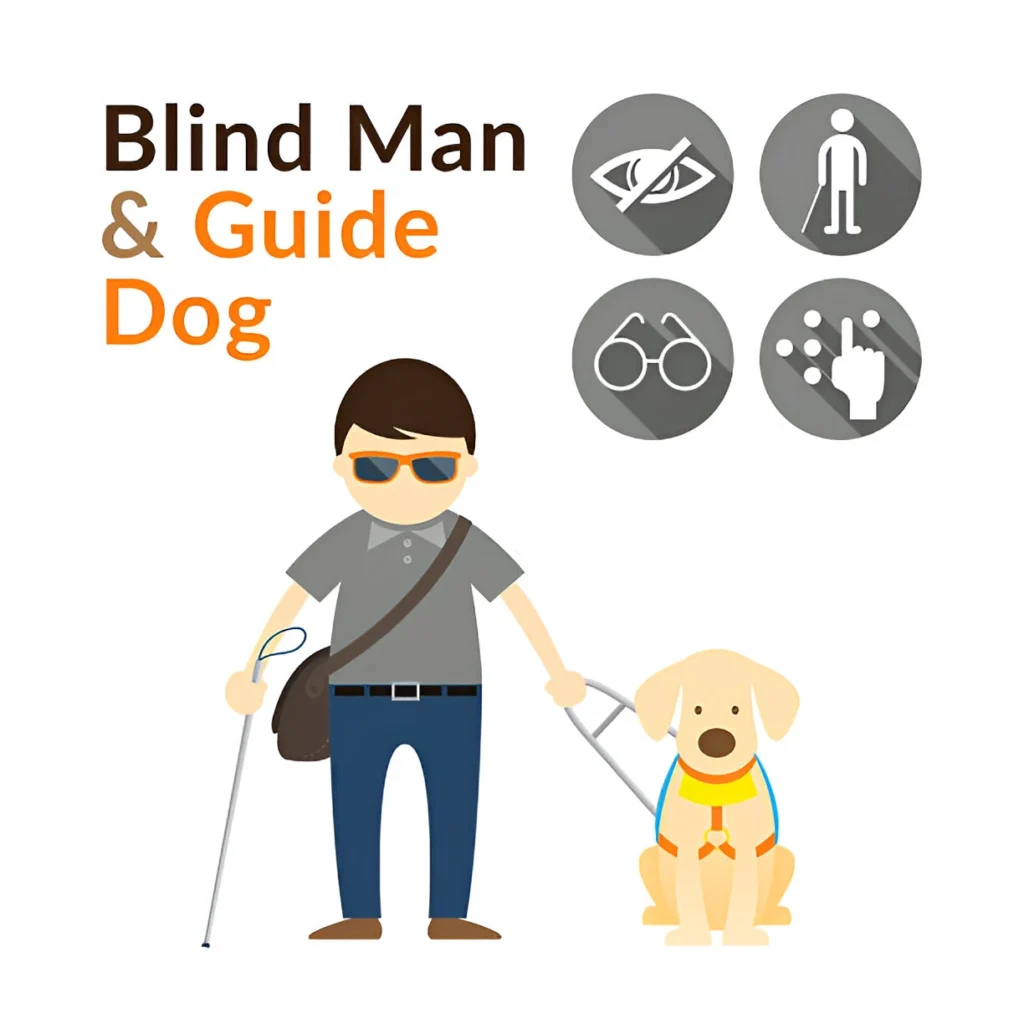
What Is the Goal of Training Service Dogs?
With the help of owner trainers, service dog training aims to build the fundamental abilities needed for a dog to perform specific service tasks.
From guide dogs assisting the blind to autism service dogs helping people with autism spectrum disorders. These dogs learn to assist people with a range of needs by participating in board and training programs.
These dogs learn vital skills through organized training, such as recognizing medical crises, assisting with mobility, or providing emotional support.
By increasing freedom and fostering priceless friendships, these service dogs can significantly enhance the quality of life for their human companions when they are trained properly.
What Kinds of Training Are There for Service Dogs?
There are many different kinds of service dog training, such as task training, specialized training for certain tasks, and public access training to ensure comfort in a range of settings.
Teaching service animals certain behaviors, such as leading people with blindness or warning people with hearing impairments, is known as task training. The goal of specialized training is to improve abilities for tasks specific to each person’s needs, like detecting seizures or assisting with mobility.
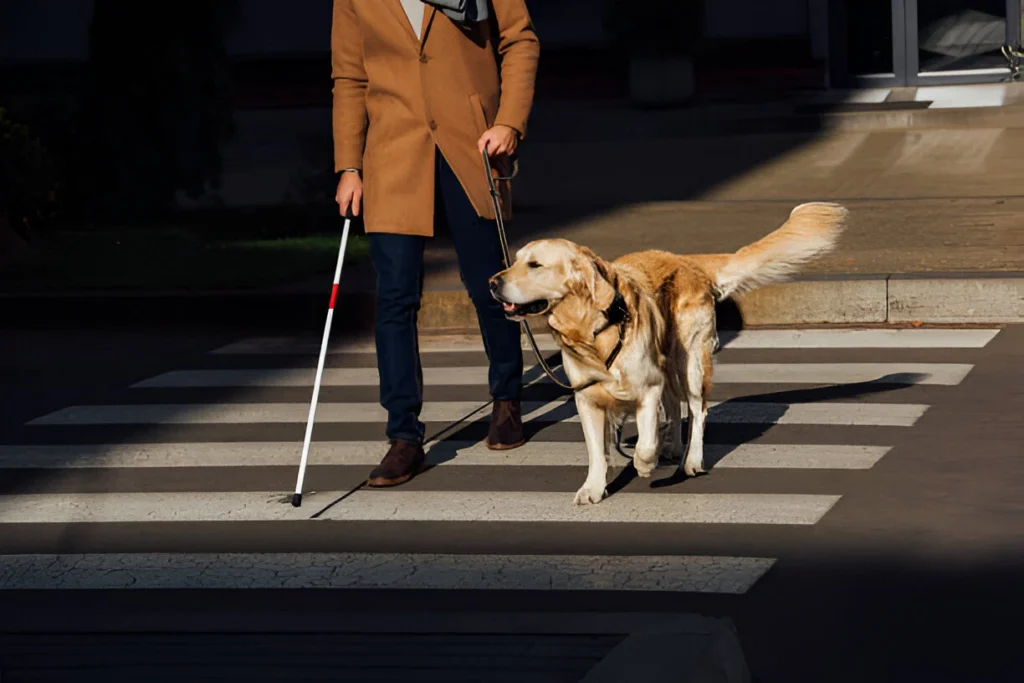
Here are the different kinds of Service Dogs:
Mobility Service Dogs:
- Assist with daily duties like finding objects, pressing buttons, or serving as a brace partner for people weighing more than 55 pounds. They may even be capable of pushing wheelchairs.
Psychiatric Service Dogs:
- For those who suffer from PTSD, depression, or anxiety, psychiatric service dogs are available. These dogs can assist their owners in readjusting to life and providing comfort when PTSD flashbacks or panic attacks occur.
- A fantastic program called Wounded Warrior Service Dogs offers service dogs to veterans of war at no cost to them. Service dogs for PTSD account for more than 19% of assistance dog teams worldwide.
Autism Service Dogs:
- These dogs can prevent danger and track a child with autism if they run away. They are ideal confidence boosters for people with autism.
Diabetic/Seizure Alert Service Dogs:
- Service dogs trained to warn their owners to check their blood sugar levels are known as diabetic or seizure alert dogs. In the event that medical assistance is required, they can also activate alarms.
Hearing Service Dogs:
- Are perfect for helping their owners become more independent by using cues to guide them to specific locations. This could be the doorbell or hearing their name.
Eye-Seeing Dogs:
- Guide dogs, also called eye-seeing dogs. These dogs are trained to help their blind owner navigate obstacles. Although many guide dogs can be given away for free, depending on the organization, or they may require an adoption fee, they usually cost between $50,000 and $60,000.
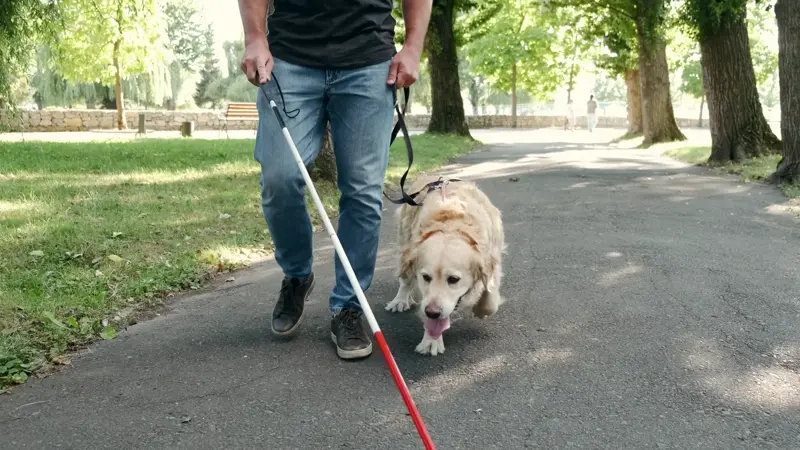
Check to See If Your Dog Qualifies for Service Dog Training
If you want to train a dog for service, there are a few things you should consider because they will determine whether your dog is capable of the task.
Age:
- Your dog should be older than six months and have undergone spaying or neutering. Some argue that a dog will be easier and more responsive to training if it is younger. However, this isn’t always the case. Starting basic training when they are puppies is a great idea.
Temperament:
- A service dog’s temperament should remain composed and easygoing, even under pressure. Distraction should not be a problem for them.
Socialization:
- Your dog should know how to interact with people. This can be reduced by early exposure to people, various environments, and other animals.
How Much Does Training a Service Dog Cost?
Service dog training is an expensive investment, with prices ranging from $30,000 to $60,000, depending on the type. However, it’s worthwhile if you lack the time to train a service dog yourself.
You can try using Paws with a Cause or other grants, among other funding sources, to get financial support. The task you are training the dog for, its breed, and other factors all affect dog training cost.
When feasible, it is more economical to train a service dog yourself. Plenty of online courses and software are available to assist.
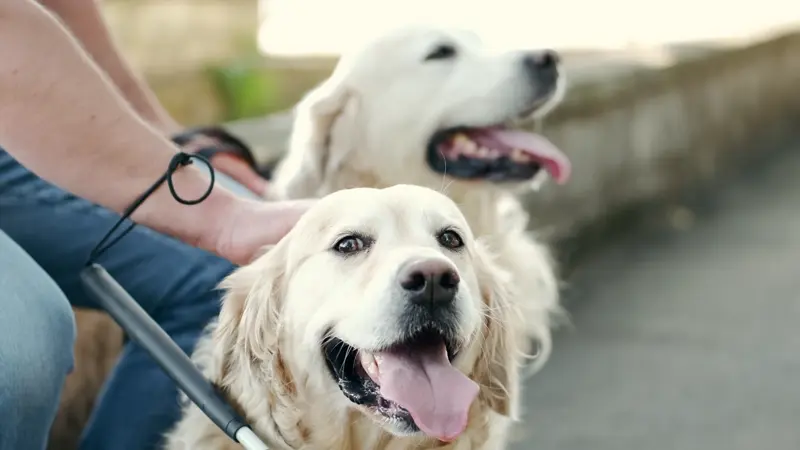
Is a Certificate Required for My Service Dog?
It is a common misconception that a service dog must be certified, but this is not true. Certification is not necessary, according to the ADA. There are several certifications available online. However, the government won’t accept them.
Certification, however, can eventually be used as evidence if critical.
Choose the Best Service Dog for Your Needs
It can take thousands of dollars and a lifetime to train a service dog. Many people, however, would be unable to function and would live in extreme disadvantage without them.
Service dogs, such as guide dogs, hearing dogs, and autism service dogs, help people with physical, neurological, or mental disabilities manage their daily lives.
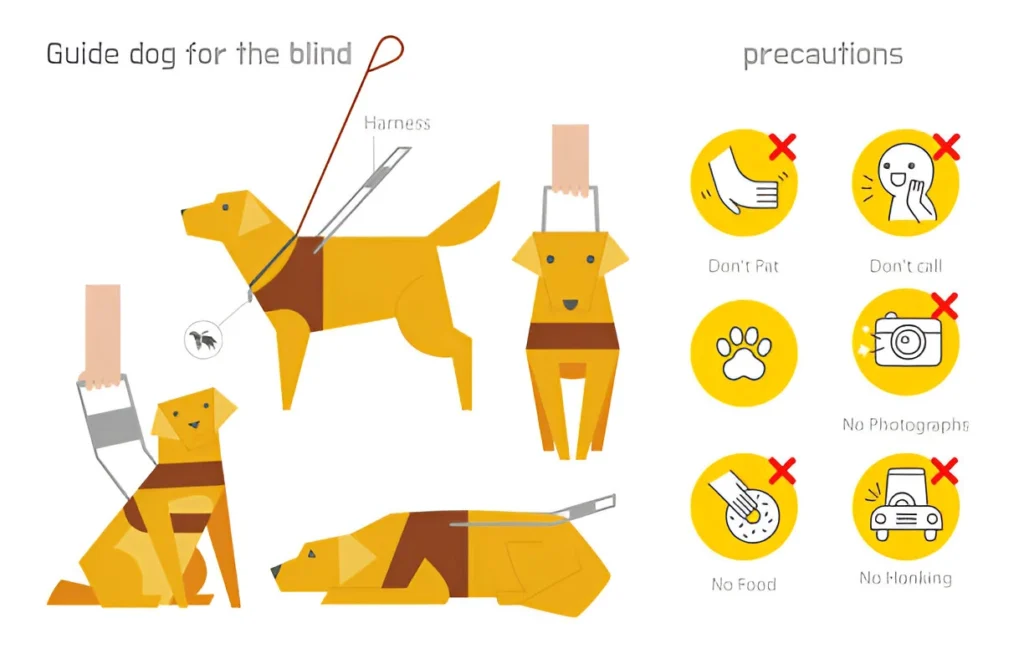
Requirements for Training a Service Dog
According to the Americans with Disabilities Act (ADA), service dogs are “individually trained to do work or perform tasks for people with disabilities.” This indicates that their training directly supports and is customized for their handler in a variety of tasks.
Along with specific training, a service dog also needs to be prepared in public access etiquette. They must, therefore, behave well in public and not always be ruled by their handler.
In order to maintain their status, they must be able to obey voice commands or other signals, unless their handler’s disability prevents them from being tied or harnessed.
How to Turn Your Dog into a Service Dog
Do you have aspirations of turning your devoted dog into a service dog who can help someone in need? The process of turning your dog into a service dog is a fulfilling and significant one in this careful manual.
Hence, we’ll go over each step of how to turn your dog into a service dog. Also, we can handle the whole thing from deciding if your dog yields with legal requirements to training methods and even managing public access.
Understanding Service Dogs
Service dogs are highly trained working dogs that help people with disabilities. They are more than just pets. These amazing animals are capable of a wide range of duties, such as warning people with illnesses and assisting the blind.
It’s crucial to grasp the following basic ideas before starting the process of creating a service dog:
Evaluating the Suitability of Your Dog:
- Learning how to turn your dog into a service dog is a very vital step. Deciding if your dog meets the requirements to become a service dog is the first step in this great journey.
- While it is possible to train any breed, some features are essential: Service dogs need to have a calm, self-assured, and calm temperament. They need to remain calm under pressure.
Trainability:
- Service dogs should be receptive to training cues and eager to learn. A solid foundation in basic obedience training is essential.
Health:
- Your dog should be free from debilitating illnesses and in excellent physical condition.
Socialization:
- It’s crucial to start socializing early. Your dog will become more situationally adaptive if they are exposed to a variety of people, animals, and environments.
Age:
- The majority of dogs start service dog training as puppies, though there isn’t a set age limit.
Aggression:
- Neither people nor other animals can be the target of a service dog’s aggression.
Types of Service Dogs
The purpose of service dogs’ training is to assist individuals with disabilities. Your mental, intellectual, psychiatric, sensory, and physical health may be impacted by those conditions.
Dogs can be trained to pull wheelchairs, fetch medicine, remind you to take it, help you walk steadily, and warn you of potentially dangerous objects or important noises.
- Signal dogs or hearing aids that notify those who are hard of hearing of noises in a space.
- Dogs that assist those in wheelchairs or with physical disabilities in carrying objects or opening doors.
- Guide dogs that help people with vision impairments navigate their surroundings.
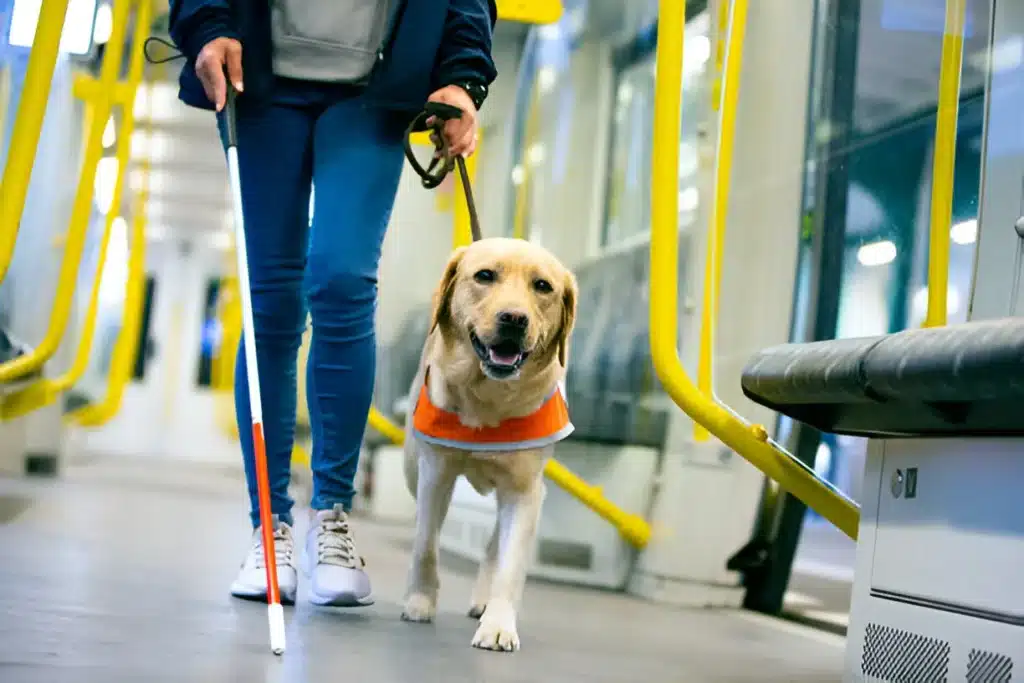
How Much Do Service Dogs Cost?
A service dog can cost up to $25,000 to train, which may include follow-up work and owner education sessions. Also, you will learn by hiring the best dog trainer.
While some service dog providers are profit-making companies, others are non-profit organizations. Organizations exist that offer financial assistance or free service dogs.
Getting a Service Dog: A Guide
Laws restricting self-training are non-existent. Yet, hiring qualified trainers to train your service dog is advised.
Instruction:
- Anyhow you obtain a service dog, they typically undergo a rigorous training regimen with a qualified trainer. The service dog spends time with you and the instructor during the final month of training.
- In addition to teaching you how to command, handle, and care for the dog, the instructor teaches the dog to specifically assist you.
Organizations:
- You can get service dogs for free or receive a grant to purchase one from certain non-profit training organizations. Some may impose a fee.
- Working with a seasoned organization is crucial. Before selecting a dog, get referrals and thoroughly inspect them.
Do Laws Exist Regarding Service Dogs?
Certain laws are helpful if you have a service dog. Even though ordinary dogs are denied, a service dog is typically allowed to join you wherever you go.
Local Laws:
- For service dogs to be licensed, registered, and vaccinated, they must adhere to local regulations and public health standards. They are therefore not allowed to swim in public pools.
- Signing up your dog as a service dog is not mandatory. Due to the nature of their breed, service dogs cannot be denied.
Under Control:
- The handler of a service dog must always maintain control over them. They cannot, therefore, be left alone in public areas or hotel rooms. Unless they are operating off-leash, they must be obedient and on a leash. The dog could, for instance, be let loose to investigate or retrieve something.
Privacy:
- The only questions an employee in a public setting can ask you are whether the dog is a service animal required for a disability and what tasks it is trained to perform.
- Employees are not allowed to request that you present your service dog performing tasks. Employees are also not allowed to inquire about your disability or request papers.
Vests:
- Wearing a vest is not a must when your service canine is out in public. Some owners of service dogs prefer to wear vests to prevent unauthorized public handling of their pets.
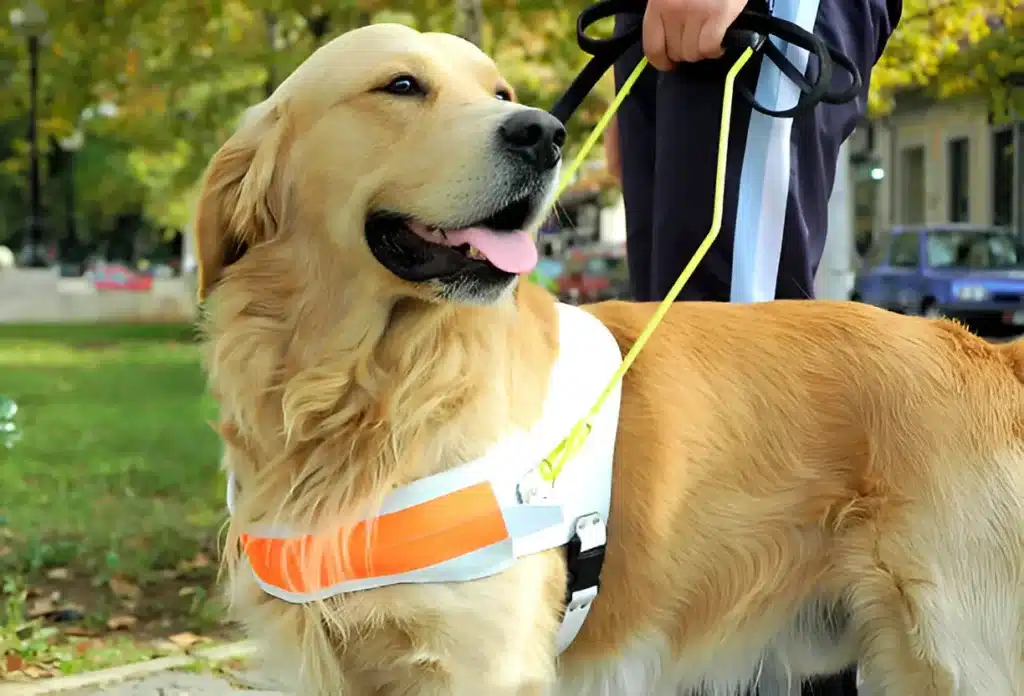
Steps for Owner Training
Here are the crucial actions to take in the event that you choose to assume owner training:
Step 1: Define Particular Duties:
- Find out what distinct duties your service dog will have to carry out. The person with a disability should directly benefit from these activities. A medical alert dog might have to recognize variations in blood sugar levels, for instance.
Step 2: Basic Training in Obedience:
- Develop your dog’s basic obedience skills. Cues such as sit, stay, come, and heel are included in this. A solid obedience foundation is vital for advanced training.
Step 3: Enhanced Training for Particular Tasks:
- Go on to task-specific training after you have mastered basic obedience. You will need to train your dog to open doors or retrieve objects, for instance, if they are helping someone with mobility issues.
Step 4: Instruction for Public Access:
- Teach your dog how to act properly in public. This entails remaining composed, non-intrusive, and receptive to your cues.
Step 5: Getting to Know Others:
- Expose your dog to a range of situations, people, and habitats. As a result, your dog gains self-assurance and flexibility.
What Tasks Do Psychiatric Service Dogs Perform?
You might find it helpful to read about the benefits of psychiatric service dogs. If you have social anxiety and are unsure about whether to get a service dog or an ESA, you can learn from expert dog trainers.
The following are some task examples:
- Alerting you to the fact that your anxiety is rising. So you can leave the situation or location before it becomes too much for you.
- Reminding you to take your medicine at the appointed time.
- Helping you find a seat or a secure location during a panic attack. Also, if the need arises, remove you from the situation.
- Putting up a wall between you and other individuals.
- Offering you a hug if you’re lying on the ground or feeling lightheaded.
Things to Watch Out For
Be mindful of legal requirements, thoroughly research training programs, and be prepared to answer questions about your service dog’s purpose.

Recognize the law.
- There are numerous programs that offer certification for service dogs. However, these certifications do not establish the dog’s status as a service animal. In actuality, the ADA does not require any kind of certification or evidence of your service dog’s training.
Look into the program you selected.
- Do a lot of research to ensure that the training program you choose for your dog is reliable. Training courses can cost 1,000 plus USD. Be sure to get the most out of your investment. The best experience for you and your dog can be ensured by things like reviews and advice.
Verify your ability to respond to two questions.
- If your dog’s status as a service dog is not instantly apparent, the ADA states that you only need to respond to two questions:
- “Is the dog a service animal needed because of a disability?”
- “What task or job has the dog been trained to perform?”
- Both questions must be correctly answered in order for the dog to be classified as a service dog.
Registration for Service Dogs.
- As per the American Dental Association, it is unlawful to require service animals to be registered. The ADA is broken by any city that declares otherwise. However, service animals are subject to the same regional pet vaccination and registration requirements.
Taking Care of Public Access and Manners
Once trained, you’ll need to make sure your dog behaves appropriately while navigating public areas. The following advice is provided:
Access Permissions:
- Be aware of your public access rights. Most public areas permit service dogs. However, they must be well-behaved.
Strap and Leash:
- Unless it gets in the way of your service dog’s work, keep them on a leash or harness. Better control in public is thus provided.
Behavior:
- In public, your dog should remain calm and avoid causing disruptions. It’s important to ensure they don’t jump or dog barking excessively.
Public Communication:
- Inform people about service dogs. Even though people might come over to pet or admire your dog, they should first get your permission.
Hygiene:
- Make sure your dog is tidy and clean before letting them into public areas.
The Well-being and Health of Your Service Dog
Your service dog’s health and welfare come first. For them to stay healthy, regular veterinary care is necessary.
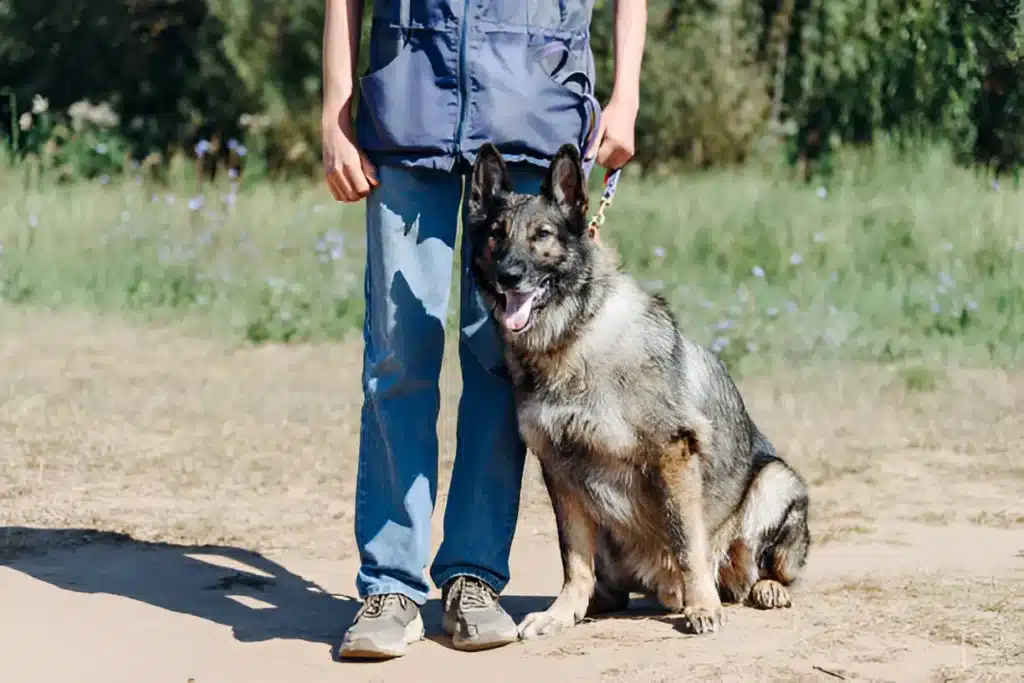
Here are some things to remember:
Health Examinations:
- Make an appointment with your veterinarian for routine examinations. This facilitates the early detection and treatment of health problems.
Exercise and Diet:
- Make sure your service dog receives regular exercise and a healthy diet. Their capacity to carry out tasks efficiently is supported by a healthy body.
Mental Stimulation:
- Just as important as physical exercise is mental stimulation. Offer your dog mentally stimulating activities to do.
Rest:
- Make sure your dog gets enough sleep. Their capacity to effectively assist may be hampered by fatigue.
Drinking Enough Water:
- Make sure your dog has access to clean water at all times. They stay properly hydrated.
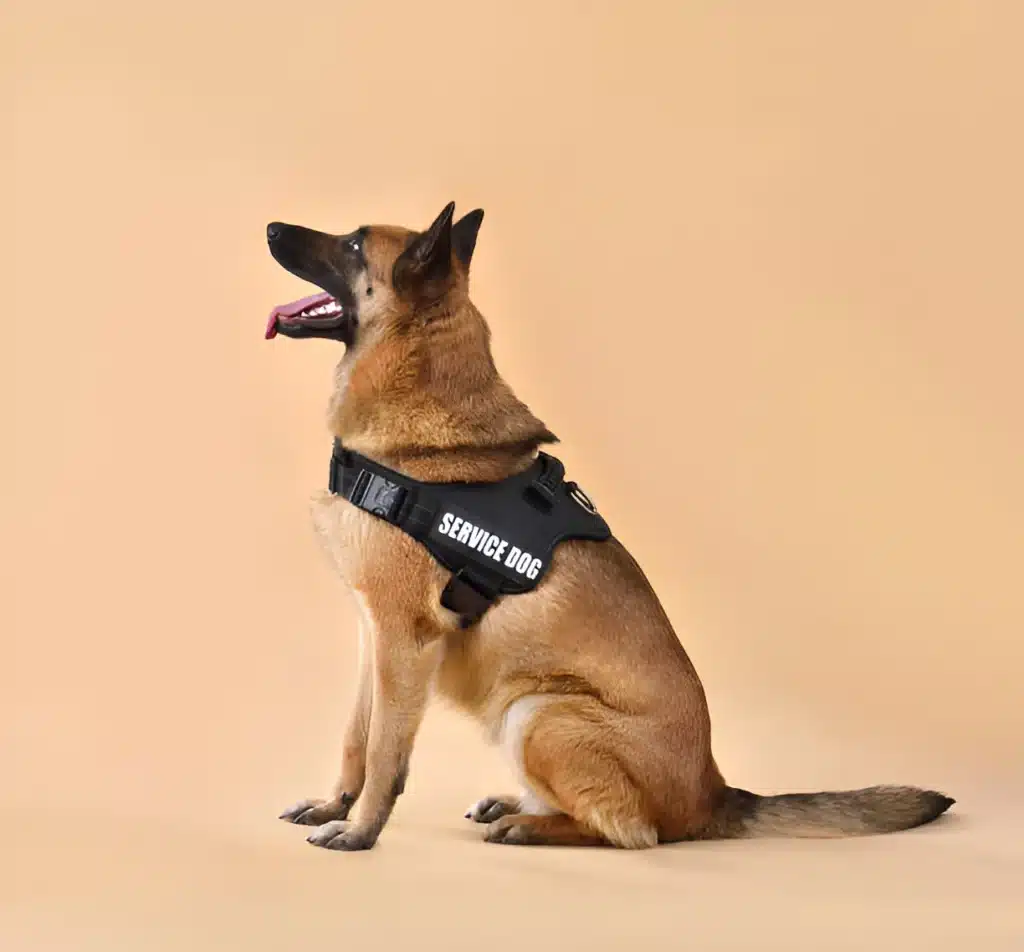
Final Note
Training a service dog is a profound journey that requires time, dedication, and specialized knowledge, but the rewards are life-changing for individuals with disabilities. These remarkable dogs, trained for tasks like mobility assistance, alerting to medical conditions, or providing emotional support, enrich lives through companionship, independence, and unwavering loyalty.
While professional training can be costly, self-training offers an alternative for those willing to invest the effort. Understanding the requirements—such as temperament, health, and task suitability—ensures the right foundation for success.
Beyond tasks, service dogs embody the human-canine bond, proving that with patience, commitment, and proper guidance, they can transform lives, making every challenge worthwhile. I hope this comprehensive guide provides valuable insights into the world of service dogs. If you have any further questions or require more specific information, please don’t hesitate to reach out to relevant organizations or consult with experienced dog trainers.

